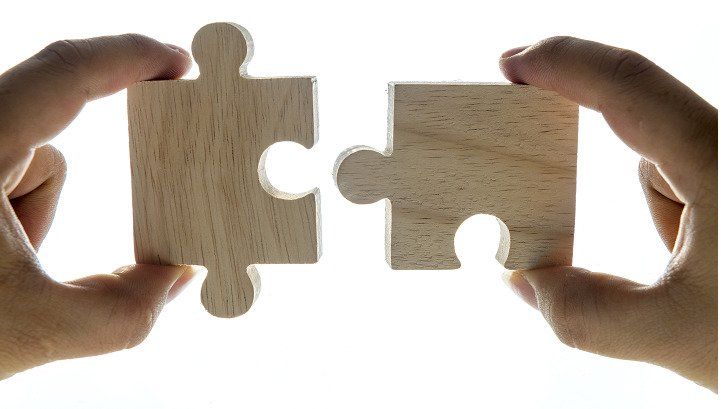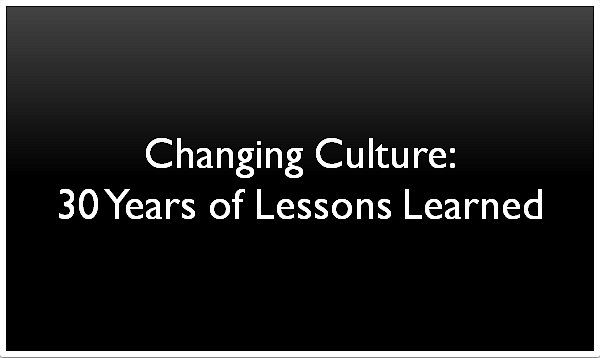
Strategies for Shaping Culture Part 3
Strategies for Shaping Culture Part 3
6. ALIGN THE ORGANIZATION SYSTEM – Support desired behaviors
Architect structures, processes, and artifacts to reinforce behaviors For new behaviors to take root, a work environment is needed where these are supported and positively reinforced. To expect otherwise is unrealistic. For example, if there is the expectation that people will make decisions that benefit other groups but at times negatively impact their own department, then the right goal setting, measurement and reward structures need to be in place to support this. Identifying the elements of the ‘system’ that support and impede the desired behaviors is the first step. Taking action to align these elements with a focus on those that are most critical for adoption and sustained change is an essential part of any enterprise culture development plan.
7. MAKE IT DESIRABLE – Tap into intrinsic satisfaction
Use positive feedback Most people want to do well, put in a good day’s work and be proud of their achievements. Research shows that people have a powerful desire to do what is right and want to hear that they are on the right track from their manager and particularly their colleagues on a regular basis. Build in lots of feedback loops. For example, to close the weekly team meeting, ask who needs to be recognized for demonstrating behaviors important to the desired culture. Allow time for people to learn about the behavior and how it was applied. Build pride in individual and team accomplishment. Research reveals that people whose work requires conceptual thinking are motivated by purpose, autonomy, and mastery. Help people tap into these three powerful factors for intrinsic motivation. For example, you might realize that the new behavior is going to create some pain before it becomes a habit. Make mastery fun by creating a game around it, increasing individual and team targets over time, posting daily results and having some friendly competition across groups. What could be an unpleasant learning situation can become a source of pride in individual and team achievement.
Build pride in individual and team accomplishment Research also reveals that people whose work requires conceptual thinking are motivated by purpose, autonomy, and mastery. Help people tap into these three powerful factors for intrinsic motivation. For example, you might realize that the new behavior is going to create some pain before it becomes as Make mastery fun by creating a game around it, increasing individual and team targets over time, posting daily results and having some friendly competition across groups. What could be an unpleasant learning situation can become a source of pride in individual and team achievement.
Conduct culture pulses Conduct regular short culture pulse surveys focused on culture priorities and share the data. Give groups their results. While this provides reinforcement that positive actions are making an impact and guidance and where to focus on next, it also leaves nowhere to hide for those groups who are opting out of the change.
Align recognition and rewards Keep recognition simple, local and targeted at a demonstration of desired values and behaviors. When extrinsic rewards are needed to accelerate culture change, focus on the outcomes desired (delivery of goals and targets).
8. MAKE IT PERSONAL – Tap into values
Talk about the link to personal values Most culture development efforts rely on personal and group motivators and let the value of personal experience with desired behaviors reinforce new ways of doing things. At times, however, there are people who are uninterested in the behaviors or resist changing their beliefs. In this case, connecting the desired behavior to an individual’s personal values can be a powerful means of helping them see how this can be positive for them. Have discussions with such individuals around organization purpose and how their personal values connect to this. Talk about what they want personally, long-term, from their lives and allow them to make their own links between desired and current behavior. Refrain from lectures or advice as this is unlikely to change thinking; this must be a dialogue. If there is no alignment between personal values and the desired culture, behavior change will be difficult to sustain.
9. NO EXCEPTIONS – 100% consistency, no excuses
Demand consistency Reinforce adoption of new behaviors and practices and demand 100% consistency – no exceptions and no excuses. Consistency builds trust and connectedness important for agility, collaboration, innovation, and productivity. When progress is slow, provide support such as coaching by the manager or an internal or external coach.
Address non-compliance As the saying goes, the chain is only as strong as its weakest link. Without consistency, groups cannot effectively work in concert and deal with complex emerging issues and inter-dependencies. Take action when needed with individuals whose behaviors weaken culture. While each leader got a chance at Ford, Mulally and his top leaders made tough people decisions in order to shape the culture year by year.
10. STORIES – Forget the PowerPoint presentation
Tell stories The best way to shape a culture is to have everyone experience what it is like. Immersion is great but too often this is not possible. Create a vicarious experience by telling about your own experiences. People do need to know two things: Will demonstrating these new behaviors be worth it? How does this apply to me? Get others to tell their stories Stories
Get others to tell their stories Stories to explore what the behavior feels like and create an empathetic reaction in the listener. We become gripped by what was on the person’s mind, the details of what it was really like and the results that were achieved. Encourage others to tell a complete story, making sure there is a clear link between the desired behaviors and the purpose and business outcomes desired. Draw out the storyteller to explain how specific behaviors brought better results. Let listeners work through the two big questions: Will it be worth it? Can I do it?
Use pilots Pilot significant changes and evaluate early behavior change to see if the behaviors are having an impact and create the outcome desired. Use early stories from these pilots to provide proof of gains ahead to those who have not yet bought into the culture change. From these, identify unintended consequences, barriers and/or gaps in support early so they can be addressed.
11. SKILLS & SUPPORT – Build competence and confidence
Build mastery New behaviors require learning which can be painful. Immerse people in demonstrating new behaviors frequently and stick at it for at least three months so habits form. At Ford, former CEO Mulally drove transparency and information sharing every day for years until everyone valued and demonstrated it.
Provide support Don’t forget about recovery support to help people get back on track when they drop new behaviors. Dig into what is impeding the desired behaviors. Leaders, peer coaches and external coaches are all social supports that can be part of gaining mastery and consistency. HR can play a key role in setting up networks of peer coaches and external coaches to support those trying hard to shift behaviors and practices.
These are some of the most powerful strategies that we have uncovered for shaping culture more intentionally for future success. If you have a strategy to share with our blog readers, feel free to comment.









